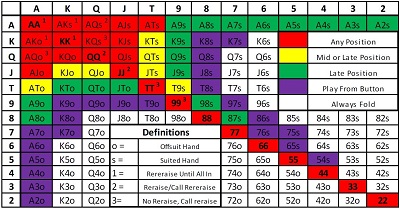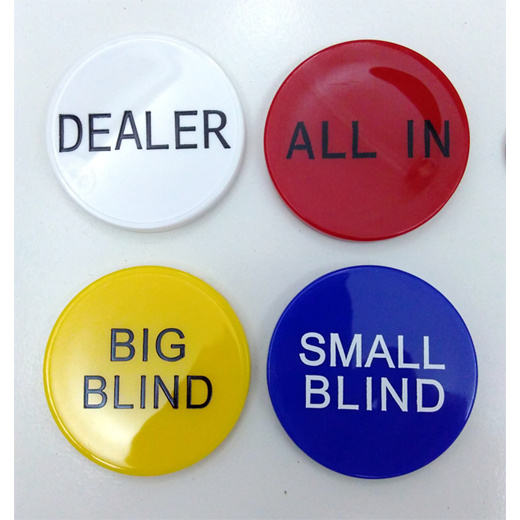Texas Hold Em Button
Posted By admin On 13/04/22
Perfect for your home games or Poker Texas Holdem Tournaments. ALL IN engraved on both sides. Button is white with black lettering. Measures 2' in diameter and 1/8' thick. Similar to the ALL IN button that was introduced at the WSOP in 2006. Our 5 piece holdem button package is a must-have addition for any poker set used for Texas Hold’em. Big Blind button is used in Hold’em games to determine who has the large forced bet. Little Blind button used in Hold’em games to determine who has the small forced bet. Missed Blind button is used in Hold’em to mark players that were away from the table and missed blind contributions. The button is a marker used to indicate who the 'dealer' in the current hand is. Obviously in a casino game, players don't deal their own cards, so the button indicates the player who is set to act last after the cards are dealt. In a home game, the player with the button (aka buck, aka dealer button) deals the cards.
In Texas Hold’em, the person who starts or goes first is dependent on what stage of the hand being played. Before the flop, the first person to act is the player seated directly to the left of the Big Blind. This seat is often referred to as Under The Gun (UTG). After the flop, the first person to act is the player seated in the Small Blind (SB) position. Thereafter, the order stays the same for the rest of the hand through the Flop, Turn, and River.
Table of Contents
What Is the Exact Order of Play?
The order of play is based on how the players are seated at the table. There are typically 6 seat names in poker. UTG (also known as first position) is divided up into multiple seats (UTG, UTG+1, UTG+2) for games larger than 6-handed.
Here is what a 6-max poker table looks like. In the chart, the seats are called Under The Gun (UTG), the Hijack (HJ), the Cutoff (CO), the Button (BTN), the Small Blind (SB), and the Big Blind (BB).
Pre-Flop Order
Before the flop, the last player to act is always the Big Blind.
On a 6-handed table, the order of play would be UTG, HJ, CO, BTN, SB, BB. Once the first player acts, play continues around the table in a clockwise fashion until it reaches the Big Blind, who acts last on the first round.
On a 9-handed table, the order of play would be that the UTG starts followed by UTG+1, UTG+2, UTG+3, HJ, CO, BTN, SB, BB.
Post-Flop Order
On the Flop, Turn, and River, the last player to act is always the Button.
Accordingly, on a 6-handed table, the post-flop order of play would be the SB starts followed by the BB, UTG, HJ, CO, and BTN.
Are There Any Exceptions?
The post-flop order never changes. However, the pre-flop order of play can be slightly altered if there is a player who straddles. A straddle is when the player seated just to the left of the Big Blind (usually UTG) posts a double big blind bet in front of him prior to the cards being dealt.
Essentially, he is buying the right to act last before the flop. In the case of a straddle, the person seated just to the left of the “straddler,” goes first pre-flop once the straddle has been wagered.
What Is the Dealing Order?
The first person to act after the flop is also the first person to receive a card; the small blind. The easy way to remember this is that the dealer must always deal clockwise to his or her left.
Who Goes First in Heads-Up Play?
The pre-flop order also changes in a heads-up match. Instead of the Button acting last before the flop, he or she acts first instead. The easy way to remember it is that the Big Blind always goes last before the flop. And, in the case of heads up, the Button is the Small Blind, and therefore acts before the Big Blind player.
During post-flop, nothing changes heads up. The button still acts last, even though technically he or she is the Small Blind.
Dealing Order For Heads-Up Play
In heads-up play, the Big Blind is dealt to first and the Button 2nd. The button always receives the last card when dealing no matter how many players are seated at the table.
What’s the Order of Play Three-Handed?
The same rules apply whether there are 3 players or 10. Before the flop, the player to act first is just to the left of the big blind. In the case of three-handed play, that would be the button. After the flop, the small blind acts first as always.
Who Bets First?
After the flop and before action is opened, any player can perform one of two actions. They can either bet or check. Of course, the person who acts first has the first option to bet.
When Does a Poker Hand End?
There are a couple of ways that a poker hand can end. First, someone can bet and all the other players fold. This can happen on any street. The second time a hand can end is when the action closes on the river and showdown is achieved. In the latter case, all live hands are revealed and the winner is determined.
Who Shows Their Cards First at Showdown?
Once the hand has ended on the river and showdown has been achieved, the order that each player reveals their hand is exactly the same as the post-flop betting order. The first person to reveal is always the first person to the left of the Dealer and the last person to reveal is the player on the button.
Of course, if a player only has to show their hand if they want to. Many players will choose to “muck” or throw away their hand instead of showing if they are sure they have no chance of winning the hand at showdown. This is sometimes a wise choice in order to not give away information about your hand.
Is It Better to Act First or Last?
Being in position (acting last) is much better than being out of position (acting first) in poker. Poker is an informational game and the person that gets to act last has more information than everyone else. I wrote a detailed article on position; check it out for more details.

What Is the Best Position at a Poker Table?
Since we have established that acting last is most advantageous in poker, the Button would be the best seat at the table. However, in reality, the seat name is irrelevant, as long as you are acting last. Therefore, let me refine my definition slightly: the best seat in poker is any seat that has you acting last in the current hand on the current street. For example, if it is blind versus blind after the flop, then the player in the Big Blind has the best seat possible for that hand.
Why Is It Called the Dealer Button?
When poker began the players had to deal the cards. In order for everyone to get equal opportunity to share the burden of dealing, the moving dealer button was born. Today, in casinos and even in some home games, there are dedicated dealers to speed up play, enforce the rules, and lessen the likelihood of cheating.
Why Do the Blinds Act Last Before the Flop?
The exact reason that the blinds act last before the flop has been lost to history. However, one could deduce that the reasoning is simple. Since the blinds are the only players to pay to play a particular hand, it only makes sense that they should be rewarded by being given an informational advantage via acting last. This theory is bolstered by the existence of “straddles” where one can essentially “buy” position before the flop.
Who Goes First in Pot Limit Omaha?
There is no difference between Texas Hold’em and Pot Limit Omaha (PLO) when it comes to the order of play. In fact, the order of play is the same for every poker game that has two blinds and a dealer button.
The blinds are forced bets posted by players to the left of the dealer button in flop-stylepoker games. The number of blinds is usually two, but it can range from none to three.
The small blind is placed by the player to the left of the dealer button and the big blind is then posted by the next player to the left. The one exception is when there are only two players (a 'heads-up' game), when the player on the button is the small blind, and the other player is the big blind. (Both the player and the bet may be referred to as big or small blind.)

After the cards are dealt, the player to the left of the big blind is the first to act during the first betting round. If any players call the big blind, the big blind is then given an extra opportunity to raise. This is known as a live blind. If the live blind checks, the betting round then ends.
Generally, the 'big blind' is equal to the minimum bet. The 'small blind' is normally half the big blind. In cases where posting exactly half the big blind is impractical due to the big blind being some odd-valued denomination, the small blind is rounded (usually down) to the nearest practical value. For example, if the big blind in a live table game is $3, then the small blind will usually be $1 or $2 since most casinos do not distribute large quantities of $0.50 poker chips.
The blinds exist because Omaha and Texas hold 'em are frequently played without antes, allowing a player to fold his hand without placing a bet. The blind bets introduce a regular cost to take part in the game, thus inducing a player to enter pots in an attempt to compensate for that expense.
It is possible to play without blinds. The minimum bet is then the lowest denomination chip in play, and tossing only one chip is considered as a call. Anything higher than that is considered a raise. Poker without blinds is usually played with everyone posting an ante to receive cards.
Blinds in cash games[edit]
Texas Hold'em Button Rules
In cash games, otherwise known as ring games, blinds primarily serve to ensure all players are subject to some minimum, ongoing cost for participating in the game. This encourages players to play hands they otherwise might not, thereby increasing the average size of the pots and, by extension, increasing the amount of rake earned by the cardroom hosting the game.

In cash games, the amount of the blinds are normally fixed for each particular table and will not change for the duration of the game. However, many cardrooms will allow blind levels to change in cases where all players unanimously agree to a change. Larger cardrooms will often include tables with different blind levels to give players the option of playing at whatever stakes they are most comfortable with. In online poker, blinds range from as little as one U.S. cent to USD1,000 or more.
The minimum and maximum buy-in at a table is usually set in relation to the big blind. At live games, the minimum buy-in is usually between 20 and 50 big blinds, while the maximum buy-in is usually between 100 and 250 big blinds. Some online cardrooms offer 'short stack' tables where the maximum buy-in is 50 big blinds or less and/or 'deep stack' tables where the minimum buy-in is 100 big blinds or more.
Missed blinds[edit]
In cash games that do not deal cards to players who are absent from the table at the start of the hand (or, in online games, are designated as 'sitting out'), special rules are necessary to deal with players who miss their blinds.
In such a situation, if a player misses his or her big blind, he or she will not be dealt in again until the button has passed. At that point, if the player wishes to rejoin the game, he or she must 'super-post' - he or she must post both the big and small blinds in order to be dealt cards. Of these, only the big blind is considered 'live' while the small blind is 'dead' - it is placed in the center of the pot apart from the big blind and will not count towards calling any additional bets or raises by other players. If the player has only missed the small blind, then the same procedure applies except that the player only has to post the 'dead' small blind to rejoin the game. Most cardrooms allow players to relieve themselves of these obligations if they wait until they are again due to post the big blind before rejoining the game.
Texas Hold Em Dealer Button
Some cardrooms hosting live cash games do not allow players to miss and/or avoid paying blinds in this manner. In these games, all players with chips on the table are dealt in whether or not they are present at the table. Any blinds due will be posted from the player's stack - depending on the cardroom's rules this will be done either by the dealer, another cardroom employee or a nearby player under staff supervision. Whenever a player has not returned to the table by the time it is his turn to act, his or her hand is automatically folded. Under such rules, if a player wishes to be absent from the table then the only way he or she can avoid paying blinds is to cash out and leave the game altogether.
Blinds in tournament play[edit]
In poker tournament play, blinds serve a dual purpose. In addition to the purpose explained above, blinds are also used to control how long the tournament will last. Before the tournament begins, the players will agree to a blinds structure, usually set by the tournament organizer. This structure defines how long each round is and how much the blinds increase per round. Typically, they are increased at a smooth rate of between 25% and 50% per round over the previous round. As the blinds increase, players need to increase their chip counts (or 'stacks') to stay in the game. The blinds will eventually consume all of a player's stack if he or she does not play to win more.
Unlike many cash games, it is not possible for a player to 'miss' blinds in a tournament. If a player is absent from the table, he will continue to have his or her cards dealt and mucked and will have blinds and, if applicable, antes taken from his stack as they are due, either until he or she returns or until his or her stack is completely consumed by blinds and antes. A player who loses his or her chips in this manner is said to have been 'blinded off.'
Goals[edit]
There are two main goals for the blinds structure:
- Ensure that by the time the desired duration of the tournament is reached, it will be very hard for players with small stacks to stay in the game. This forces players with smaller stacks to play them aggressively, thus increasing their chip count or losing everything quickly.
- Ensure that players, in general, do not have a large stack relative to the blind level.
If desired, antes can be added to further increase the pressure to win more chips.
Example[edit]
If each player in a tournament starts with 5,000 in chips and after four hours, the big blind is 10,000 (with a small blind of 5,000), it will be very difficult for a player with only 15,000 in chips to stay in the game.